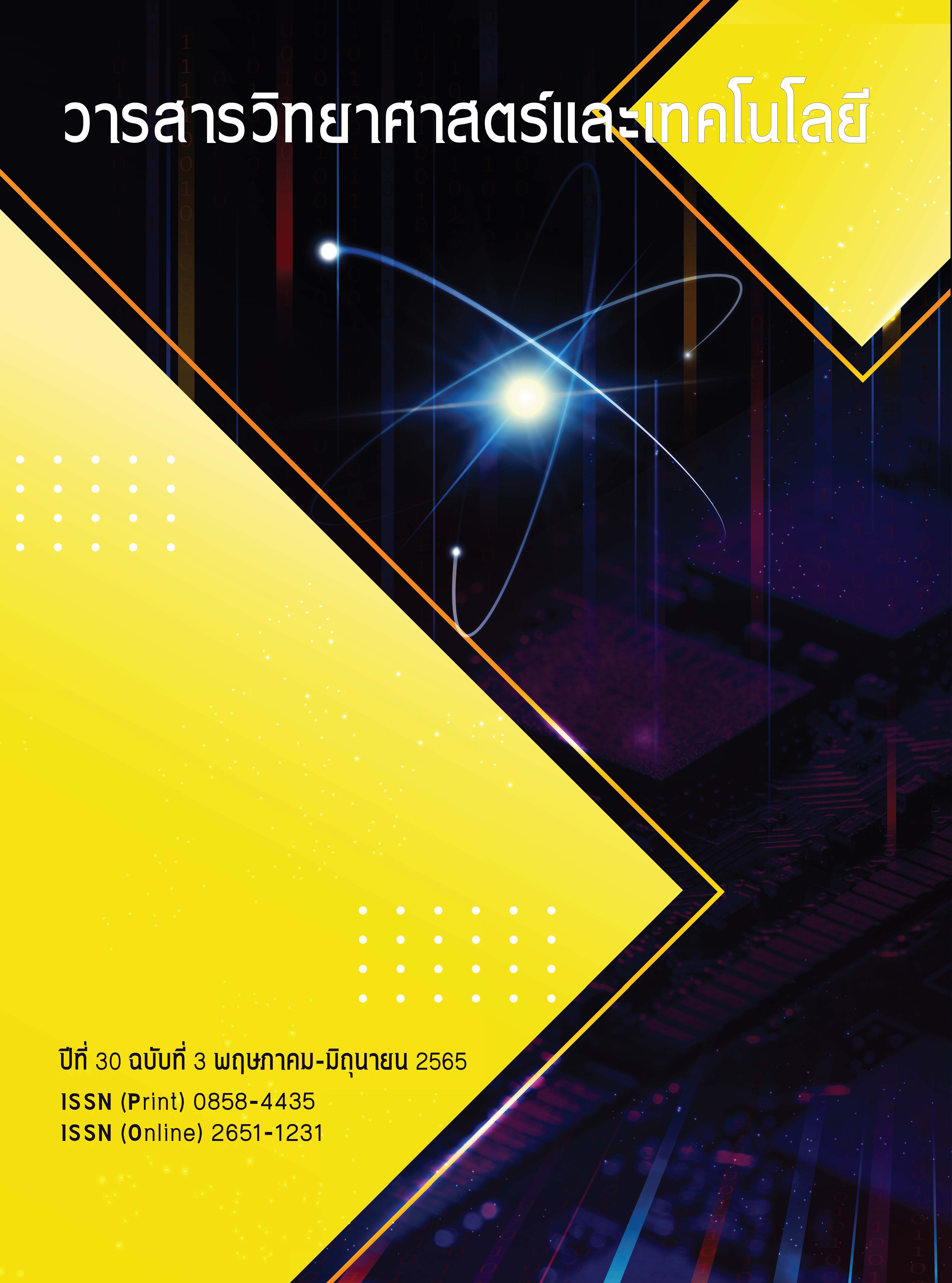Feasibility Study in Develop the Rotating Electrodes, Electrostatic Air Cleaner for Removal Particulate Matter from Indoor Air
Main Article Content
Abstract
This paper aims to conduct a feasibility study to develop the rotating electrodes and
electrostatic air cleaner to remove particulate matter from indoor air. An electrostatic air cleaner prototype consists of a rotating electrostatic particle collector, a DC high voltage power supply, and an airflow control system. In this system, a fan draws a sample air into the system through the
rotating electrostatic particle collector to charge and collect the particulate matter to improve the clean air quality. In this study, the collection efficiency of particulate matter of the prototype was tested by the aerosol particle generator inside the 2 x 2 x 2 m test chamber. The gravimetric air sampling method was used for sampling the mass of particulate matter inside the test chamber for the testing time of 15, 30, 45, and 60 min. It was found from the experiment that high corona
voltage and long testing time increased the collection efficiency of particulate matter of the
prototype. It was shown that the prototype of the developed air cleaner could effectively remove particulate matter up to 91.20% at the testing time of 60 minutes. It was also found that the
rotating electrodes and self-cleaning system can be used with electrostatic precipitation air cleaner systems, which can reduce the operational maintenance of the collection electrode plates.
Article Details
References
Iqualityair., 2021, Air purifiers protect against Covid 19, TH Robotics Company Limited, Bangkok, Thailand.
Intra, P., 2019, Electrostatic aerosol measurement and control technology, ChulaPress, Bangkok. Thai.
Intra, P., Yawootti, A., Asanavijit, V. and Vinitketkumnuen, U., 2012, Development of an indoor air cleaner for a non toxic room by electrostatic technique, KMUTT Research and Development Journal,35(3): 361-382.
Jaworek, A., Krupa, A. and Czech, T., 2007, Modern electrostatic devices and methods for exhaust gas cleaning: A brief review, J. Electrostatics. 65: 33-155.
Kalasee, W., Srisang, N., Suppatkul, P. and Tekasakul, P., 2006, The Particles Collection Efficiency of an Electrostatic Precipitator Part I: Soot and Talcum Powder particles, The 20th Conference of Mechanical Engineering Network of Thailand, Nakhon Ratchasima, 18-20 October, 75-79.
Leiva G, M.A., Santibañez, D.A., Ibarra E, S., Matus C, P. and Seguel, R., 2013, A five-year study of particulate matter (PM2.5) and cerebrovascular diseases, Environmental Pollution, 181:1-6.
Masuda, S., Hosokawa, S., Tu, X.-L., Tsutsumi, M., Ohtani, T., Tsukahara, T. and Matsuda, N., 1993, The performance of an integrated air purifier for control of aerosol, microbial, and odor, IEEE Transactions on Industry Applications, 29:774-780.
Hoenig, S.A., Sill, G.T., Kelley, L.M. and Garvey, K.J., 2012, Destruction of bacteria and toxic organic chemicals by a corona discharge, Journal of the Air Pollution Control Association, 30(3): 277-278. [9] Hinds, WC., 1999, Aerosol Technology, John Wiley & Sons, New York.
USEPA, 1998, PM 2.5 general information, Office of Air Quality Planning and Standards.
Okubo, M., Yamamoto, T., Kuroki, T., and Fukumoto, H., 2001, Electric air cleaner composed of nonthermal plasma reactor and electrostatic precipitator, IEEE Transactions on Industry Applications, 37: 1505-1511.
Tintachart, K., Norkaew, W., Yawootti, A. and Intra, P., 2017, Modification and Field Testing of an Indoor Electrostatic Air Purifier, Journal of KMUTNB, 27(1): 31-46.
Okubo, M., Yamamoto, T. and Kuroki, T., 2001, Electric Air Cleaner Composed of Non-thermal Plasma Reactor and Electrostatic Precipitator, IEEE Transactions on Industry Applications, 37(5):1505-1511.
Joon Kim, H., Han, B., Woo, C., Jin Kim, Y., Taek Lim. and Gyu Shin, W., 2001, Air cleaning performance of a novel electrostatic air purifier using activated carbon fiber filter for passenger cars, IEEE Transactions on Industry Applications,53(6): 5867-5874.
Afshari, A., Ekberg, L., Forejt, L., Mo, J., Rahimi, S., Siegel, J., Chen, W., Wargocki, P., Zurami, S. and Zhang, J., 2020, Electrostatic Precipitators as an Indoor Air Cleaner-A Literature Review, Sustainability, 12(21): 2-22.
saVRee 3D Interactive Media, 2020, Electrostatic precipitator (ESP), Available Source: https://savree.com/en/encyclopedia/electrostatic-precipitator-esp[17] Parker, K.R., 1997, Applied Electrostatic Precipitation, Blackie Academic & Professional, New York.
White, H.J., 1963, Industrial Electrostatic Precipitation, Addison-Wesley, Reading, Massachusetts.
Chang, J., Kelly, A.J. and Crowley, J.M., 1995, Handbook of Electrostatic Processes, Marcel Dekker, Inc., New York.
Asanavijit, V. and Kornpod, M., 2017, Prototype Development of a ClosedLoop Control Type Electrostatic Precipitator for Smoke Removal of Incinerators, Journal of Innovative Technology Research, 1(1): 71-82.
Asanavijit, V., Premrudeepreechacharn, S., Yawootti, A. and Intra, P., 2011, Current-voltage characteristics of positive corona pulsed electrostatic precipitator, pp. 359-363, The 9th PSU Engineering Conference, Phuket, 2-3 May.
Srisang, N., Chaiypong, S., Kuson, P. and Kalasee, W., 2006, Efficiency of chalk particle trapping of electrostatic precipitators, Naresuan Research Conference, Phitsanulok, 26-28 July.
Tippayawong, N. and Kunanoppadon, J., 2003, Application of electrostatic technique to diesel particulate aftertreament, PSU-UNS International Conference Energy and the Environment, Hat-Yai, Songkhla, December 11-12.
Nair, S.A., Pemen, A.J.M., Yan, K., van Heesch, E.J.M., Ptasinski, K.J. and Drinken- burg, A.A.H., 2004, Tar removal from biomass derived fuel gas by pulsed corona discharges a chemical kinetic study, Ind. Eng. Chem. Res. 43: 1649-1658.
Cytivalifesciences, 2022, Whatman Grade EPM 2000 Air Sampling Filter, Available Source: https://www.cytivalifesciences.com/en/us/shop/whatman-laboratory-filtration/glass-and-quartzmicrofiber-filter/binderlessglassmicrofiber-filter/whatman-grade-epm-2000-airsampling-filter-p-00698
Intra, P., Yawootti, A., Vinitketkumnuen, U. and Tippayawong, N., 2012, Development of a PM2.5 sampler with inertial impaction for sampling airborne particulate matter, Korean Journal of Chemical Engineering, 29: 1044–1049.


